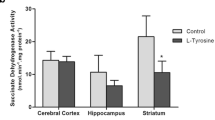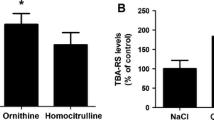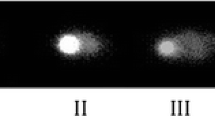Abstract
Lysine (Lys) accumulation in tissues and biological fluids is the biochemical hallmark of patients affected by familial hyperlysinemia (FH) and other inherited metabolic disorders. In the present study we investigated the effects of acute administration of Lys on relevant parameters of energy metabolism and oxidative stress in striatum of young rats. We verified that Lys in vivo intrastriatal injection did not change the citric acid cycle function and creatine kinase activity, but, in contrast, significantly inhibited synaptic Na+,K+-ATPase activity in striatum prepared 2 and 12 h after injection. Moreover, Lys induced lipid peroxidation and diminished the concentrations of glutathione 2 h after injection. These effects were prevented by the antioxidant scavengers melatonin and the combination of α-tocopherol and ascorbic acid. Lys also inhibited glutathione peroxidase activity 12 h after injection. Therefore it is assumed that inhibition of synaptic Na+,K+-ATPase and oxidative damage caused by brain Lys accumulation may possibly contribute to the neurological manifestations of FH and other neurometabolic conditions with high concentrations of this amino acid.






Similar content being viewed by others
References
Dancis J, Hutzler J, Cox RP et al (1976) Multiple enzyme defects in familial hyperlysinemia. Pediatr Res 10:686–691
Cox RP (2001) Errors of lysine metabolism. In: Scriver CR, Beaudet AL, Sly WS, Valle D (eds) The metabolic and molecular bases of inherited disease. McGraw-Hill Inc, New York, pp 1965–1970
Cox RP, Dancis J (1995) Errors of lysine metabolism. In: Scriver CR, Beaudet AL, Sly WS, Valle D (eds) The metabolic and molecular bases of inherited disease. McGraw-Hill Inc, New York, pp 1233–1238
Cox RP, Markovitz PJ, Chuang DT (1986) Familial hyperlysinemias-multiple enzyme deficiencies associated with the bifunctional aminoadipic semialdehyde synthase. Trans Am Clin Climatol Assoc 97:69–81
Hoffmann GF (2006) Cerebral organic acid disorders and other disorders of lysine catabolism. In: Fernandes J, Saudubray J-M, van den Berghe G, Walter JH (eds) Inborn metabolic diseases. Springer, Heidelberg, pp 293–306
Woody NC (1964) Hyperlysinemia. Am J Dis Child 108:543–553
Ghadimi H, Binnington VI, Pecora P (1965) Hyperlysinemia associated with retardation. N Engl J Med 273:723
Armstrong MD, Robinow M (1967) A case of hyperlysinemia: biochemical and clinical observations. Pediatrics 39:546
Ozalp I, Hasanoglu A, Tuncbilek E et al (1981) Hyperlysinemia without clinical findings. Acta Pediatr Scand 70:951–953
Gregory JW, Beail N, Boyle NA et al (1989) Dietary treatment of hyperlysinaemia. Arch Dis Child 64:716–720
van Maldegem BT, Duran M, Wanders RJ et al (2006) Clinical, biochemical, and genetic heterogeneity in short-chain acyl-coenzyme A dehydrogenase deficiency. JAMA 296:943–952
Battisti C, Forte F, Molinelli M et al (2007) A new case of short-chain acyl-CoA dehydrogenase deficiency: clinical, biochemical, genetic and 1H-NMR spectroscopic studies. Neurol Sci 28:328–330
Tein I, Elpeleg O, Ben-Zeev B et al (2008) Short-chain acyl-CoA dehydrogenase gene mutation (c.319C > T) presents with clinical heterogeneity and is candidate founder mutation in individuals of Ashkenazi Jewish origin. Mol Genet Metab 93:179–189
Schmidt SP, Corydon TJ, Pedersen CB et al (2010) Misfolding of short-chain acyl-CoA dehydrogenase leads to mitochondrial fission and oxidative stress. Mol Genet Metab 100:155–162
Pedersen CB, Zolkipli Z, Vang S et al (2010) Antioxidant dysfunction: potential risk for neurotoxicity in ethylmalonic aciduria. J Inherit Metab Dis 33:211–222
Yiannikas C, Cordato D (1996) Familial hyperlysinemia in a patient presenting with progressive spastic paraparesis. Neurology 47:846
Nyhan WL, Ozand PT (1998) Atlas of metabolic diseases. Chapman and Hall, London, pp 76–78
Seminotti B, Leipnitz G, Amaral AU et al (2008) Lysine induces lipid and protein damage and decreases reduced glutathione concentrations in brain of young rats. Int J Dev Neurosci 26:693–698
Tonin AM, Ferreira GC, Schuck PF et al (2009) Inhibition of creatine kinase activity by lysine in rat cerebral cortex. Metab Brain Dis 24:349–360
García-Cazorla A, Rabier D, Touati G et al (2006) Pyruvate carboxylase deficiency: metabolic characteristics and new neurological aspects. Ann Neurol 59:121–127
Steenweg ME, Salomons GS, Yapici Z et al (2009) L-2-Hydroxyglutaric aciduria: pattern of MR imaging abnormalities in 56 patients. Radiology 251:856–865
Braissant O (2010) Current concepts in the pathogenesis of urea cycle disorders. Mol Genet Metab 100:S3–S12
Marin-Valencia I, Roe CR, Pascual JM (2010) Pyruvate carboxylase deficiency: mechanisms, mimics and anaplerosis. Mol Genet Metab 101:9–17
Paxinos G, Watson C (1986) The rat brain in stereotaxic coordinates. Academic Press, San Diego
Vasques V, Brinco F, Viegas CM et al (2006) Creatine prevents behavioral alterations caused by methylmalonic acid administration into the hippocampus of rats in the open field task. J Neurol Sci 244:23–29
Sigala F, Theocharis S, Sigalas K et al (2006) Therapeutic value of melatonin in an experimental model of liver injury and regeneration. J Pineal Res 40:270–279
Wyse ATS, Zugno AI, Streck EL et al (2002) Inhibition of Na+, K+ -ATPase activity in hippocampus of rats subjected to acute administration of homocysteine is prevented by vitamins E and C treatment. Neurochem Res 27:1685–1689
Ribeiro CAJ, Leipnitz G, Amaral AU et al (2009) Creatine administration prevents Na+, K+ -ATPase inhibition induced by intracerebroventricular administration of isovaleric acid in cerebral cortex of young rats. Brain Res 1262:81–88
Jones DH, Matus AI (1974) Isolation of synaptic plasma membrane from brain by combined flotation–sedimentation density gradient centrifugation. Biochim Biophys Acta 356:276–287
Evelson P, Travacio M, Repetto M et al (2001) Evaluation of total reactive antioxidant potential (TRAP) of tissue homogenates and their cytosols. Arch Biochem Biophys 388:261–266
Dutra-Filho CS, Wajner M, Wannmacher CM et al (1995) 2-hydroxybutyrate and 4-hydroxybutyrate inhibit CO2 formation from labeled substrates by rat cerebral cortex. Biochem Soc Trans 23:228S
Hughes BP (1962) A method for the estimation of serum creatine kinase and its use in comparing creatine kinase and aldolase activity in normal and pathological sera. Clin Chim Acta 7:597–603
da Silva CG, Bueno ARF, Schuck PF et al (2004) Inhibition of creatine kinase activity from rat cerebral cortex by D-2-hydroxyglutaric acid in vitro. Neurochem Int 44:45–52
Tsakiris S, Deliconstantinos G (1984) Influence of phosphatidylserine on (Na+, K+)-stimulated ATPase and acetylcholinesterase activities of dog brain synaptosomal plasma membranes. Biochem J 220:301–307
Chan KM, Delfert D, Junger KD (1986) A direct colorimetric assay for Ca2+-stimulated ATPase activity. Anal Biochem 157:375–380
Yagi K (1998) Simple procedure for specific assay of lipid hydroperoxides in serum or plasma. Methods Mol Biol 108:107–110
Browne RW, Armstrong D (1998) Reduced glutathione and glutathione disulfide. Methods Mol Biol 108:347–352
Wendel A (1981) Glutathione peroxidase. Meth Enzymol 77:325–332
Aebi H (1984) Catalase, in vitro. Meth Enzymol 105:121–126
Marklund SL (1985) Pyrogallol autoxidation. In: Greenwald RA (ed) Handbook of methods for oxygen radical research. CRC Press, Boca Raton, pp 243–247
Leong SF, Clark JB (1984) Regional enzyme development in rat brain. Enzymes associated with glucose utilization. Biochem J 218:131–138
Lowry OH, Rosebrough NJ, Lewis-Farr A et al (1951) Protein measurement with the Folin phenol reagent. J Biol Chem 193:265–275
Wheeler KP, Walker JA, Barker DM (1975) Lipid requirement of membrane Na+, K+ -dependent adenosine triphosphate system. Biochem J 146:713–722
Erecinska M, Silver IA (1994) Ions and energy in mammalian brain. Prog Neurobiol 43:37–71
Erecinska M, Cherian S, Silver IA (2004) Energy metabolism in mammalian brain during development. Prog Neurobiol 73:397–445
Mazzanti L, Rabini RA, Biagini G et al (1992) Changes in membrane fluidity and Na+/K+-ATPase activity during human trophoblast cell culture. Eur J Biochem 206:881–885
Carfagna MA, Muhoberac BB (1993) Interactions of tricyclic drug analogs with synaptic plasma membranes: structure mechanism relationships in inhibition of neuronal Na+/K+-ATPase activity. Mol Pharmacol 44:129–141
Kamboj SS, Chopra K, Sandhir R (2009) Hyperglycemia-induced alterations in synaptosomal membrane fluidity and activity of membrane bound enzymes: beneficial effect of N-acetylcysteine supplementation. Neuroscience 162:349–358
Rustin P, Rötig A (2002) Inborn errors of complex II—unusual human mitochondrial diseases. Biochim Biophys Acta 1553:117–122
Yousef MI, El Hendy HA, El-Demesdash FM et al (2002) Dietary zinc deficiency induced-changes in the activity of enzymes and the level of free radicals, lipids and protein electrophoretic behavior in growing rats. Toxicology 175:223–234
Kimmelberg H, Pahadjopoulos D (1974) Effects of phospholipid acyl chain fluidity, phase transitions, and cholesterol on (Na+K+)-stimulated adenosine triphosphatase. J Biol Chem 249:1071–1080
Abeywardena MY, Allen TM, Charnock JS (1983) Lipid-protein interactions of reconstituted membrane-associated adenosine triphosphatases. Biochim Biophys Acta 729:62–74
Halliwell B, Gutteridge JMC (2007) Cellular responses to oxidative stress: adaptation, damage, repair, senescence and death. In: Halliwell B, Gutteridge JMC (eds) Free radicals in biology and medicine. Oxford University Press Inc, Oxford, pp 187–267
Martin M, Macias M, Escames G et al (2000) Melatonin but not vitamins C and E maintains glutathione homeostasis in t-butyl hydroperoxide-induced mitochondrial oxidative stress. FASEB J 14:1677–1679
Acuña-Castroviejo D, Escames G, Macías M et al (1995) Cell protective role of melatonin in the brain. J Pineal Res 19:57–63
Reiter RJ, Melchiorri D, Sewerynek E et al (1995) A review of the evidence supporting melatonin’s role as an antioxidant. J Pineal Res 18:1–11
Reiter RJ, Guerrero JM, Escames G et al (1997) Prophylactic actions of melatonin in oxidative neurotoxicity. Ann NY Acad Sci 825:70–78
Saudubray JM, Rabier D (2007) Biomarkers identified in inborn errors for lysine, arginine, and ornithine. J Nutr 137:1669S–1672S
Grisar T (1984) Glial and neuronal Na+, K+ pump in epilepsy. Ann Neurol 16:S128–S134
Benari Y (1985) Limbic seizure and brain damage produced by kainic acid—mechanisms and relevance to human temporal lobe epilepsy. Neuroscience 14:375–403
Lees GJ, Lehmann A, Sandberg M et al (1990) The neurotoxicity of ouabain, a sodium–potassium ATPase inhibitor in the rat hippocampus. Neurosci Lett 120:159–162
Satoh E, Nakazato Y (1992) On the mechanism of ouabain-induced release of acetylcholine from synaptosomes. J Neurochem 58:1038–1044
Lees GJ (1993) Contributory mechanisms in the causation of neurodegenerative disorders. Neuroscience 54:287–322
Lees GJ, Leong W (1995) The sodium–potassium ATPase inhibitor ouabain is neurotoxic in the rat substantia nigra and striatum. Neurosci Lett 188:113–116
Zinnanti WJ, Lazovic J (2010) Mouse model of encephalopathy and novel treatment strategies with substrate competition in glutaric aciduria type I. Mol Genet Metab 100:88–91
Wyse AT, Streck EL, Barros SV et al (2000) Methylmalonate administration decreases Na+, K+-ATPase activity in cerebral cortex of rats. Neuroreport 11:2331–2334
Streck EL, Zugno AI, Tagliari B et al (2001) Inhibition of rat brain Na+, K+ -ATPase activity induced by homocysteine is probably mediated by oxidative stress. Neurochem Res 26:1195–1200
Wyse AT, Bavaresco CS, Bandinelli C et al (2001) Nitric oxide synthase inhibition by L-NAME prevents the decrease of Na+, K+-ATPase activity in midbrain of rats subjected to arginine administration. Neurochem Res 26:515–520
Streck EL, Matte C, Vieira PS et al (2002) Reduction of Na+, K+-ATPase activity in hippocampus of rats subjected to chemically induced hyperhomocysteinemia. Neurochem Res 27:1593–1598
Acknowledgments
This work was supported by grants from CNPq, PRONEX II, FAPERGS, PROPESQ/UFRGS, FINEP research grant Rede Instituto Brasileiro de Neurociência (IBN-Net) # 01.06.0842-00 and INCT-EN.
Author information
Authors and Affiliations
Corresponding author
Rights and permissions
About this article
Cite this article
Seminotti, B., Fernandes, C.G., Leipnitz, G. et al. Neurochemical Evidence that Lysine Inhibits Synaptic Na+,K+-ATPase Activity and Provokes Oxidative Damage in Striatum of Young Rats In vivo. Neurochem Res 36, 205–214 (2011). https://doi.org/10.1007/s11064-010-0302-4
Accepted:
Published:
Issue Date:
DOI: https://doi.org/10.1007/s11064-010-0302-4




